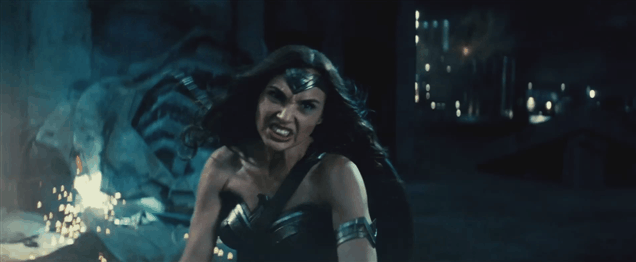![Star Blazers Got Me Through The Shittiest Year Of My Childhood]()
I was a happy child, but I didn’t have such a happy childhood. Other kids didn’t get my weird vibe, especially in elementary and middle school. And one year in particular, we moved to a new city and a new school, and things got ugly. Only one thing kept me from losing my shit: Star Blazers.
http://io9.com/5966749/six-le...
When I think back to that year of my life, Star Blazers is pretty much the main thing I remember, because most of the other memories are a blob of pure awful. Star Blazers was the Americanized version of Space Battleship Yamato, an anime series from the 1970s. These dubbed and heavily-edited versions of Yamato were airing pretty heavily in syndication in the 1980s, including every weekday afternoon on Channel 56 in Boston (also the home of the legendary Creature Double Feature.)
Every day when school ended, I would take off running. I was out of the chair before the bell even tapered off, and into the hallway. I ran like my life depended on it, because there were kids I wanted to avoid running into after school at all costs — but also, I knew if I made it home without being terrorized, I had Star Blazers to look forward to.
When I write about bullies and feeling isolated in my new book All the Birds in the Sky, I’m thinking back to that time in my life. And when I think about mad science and magic helping my two main characters to survive being misfits, I’m definitely remembering how Star Blazers gave me an escape.
http://www.amazon.com/All-Birds-Char...
I don’t think a narrative had seized hold of my brain in the same way that Star Blazers did, before this point. It was the combination of high drama and aggressive serialization. The crew of the Yamato (or the Argo, in English) were constantly running from one terrible situation to the next, and their poor old ship was always pushed to its breaking point.
![Star Blazers Got Me Through The Shittiest Year Of My Childhood]()
And nothing was ever fully resolved — every escape from danger was only a temporary reprieve. Situations carried over from episode to episode, unlike most U.S. TV of the 1980s and early 1990s, and as I shrank in my chair in the squirming overstuffed classrooms, half my brain was listening to the teacher while the other half was wondering just how the latest cliffhanger would be resolved. Plus the deadly threats to Earth only escalated over time, and the journey progressed — the first bunch of episodes deal with just leaving our solar system. There was even an episode-by-episode countdown of how long Earth had left to live.
In Star Blazers (and Yamato), some aliens called the Gamilons attack the Earth with deadly radiation. The whole planet will be dead in a year, unless a crew of humans travels to the distant planet Iscandar and obtains a cure. To this end, the humans refit an old sunken World War II battleship, using alien technology, and fly across the cosmos, fighting the Gamilons as they go.
And then, in the second season, the Earth is menaced by the evil Comet Empire, which really is a frickin comet piloted by evil, all-powerful aliens. In order to survive, the crew of the Yamato is forced to team up with their old nemesis, Gamilon leader Desslok (or Desslar, in Japanese.)
I’ll be real: the main thing I loved about Star Blazers was the ship. The characters were awesome, and I’ll get to them in a minute, but the Yamato (or the Argo, in English) was the star of the show for me. Way more than the Enterprise felt like the star of Star Trek. Much like the TARDIS on Doctor Who, this was a starship that felt incongruous — like it shouldn’t be spaceworthy, it shouldn’t even be out there at all, much less racing hundreds of light years across the universe. The very fact that we were depending on a World War II battleship in space just underscored how desperate the situation was.
![Star Blazers Got Me Through The Shittiest Year Of My Childhood]()
And the Argo was the most long-suffering ship of all time. It was submerged in seas of acid. It was hit with mines. It sustained direct hits from missiles, lost one of its bridges, had its hull shredded, and had pieces flying off it all the time. The distress of the Argo, like that of its crew, felt like a physical thing: engines straining, hull bursting, lines streaking across the screen. The fact that it kept flying and outsmarting the vastly superior forces of the Gamilons and the Comet Empire seemed like a miracle borne of pure determination.
Survival, at all costs.
So I was at this new school, where I didn’t know anyone, and it was way bigger and more chaotic than any school I’d been to before. Budget cuts had just hit this particular school really hard, so classes were being combined, with 40 or 50 kids in a room with one teacher. This was the beginning of the gutting of public education, and you could feel the exhausted panic spreading among the teachers as they realized that teaching, as they had known it, was over.
This was the first school I’d ever been to where one kid beat up another kid in the classroom, as in one kid was on the ground and the other kid kept kicking, and the teacher just carried on talking as if she hadn’t noticed.
This particular school also had a weird system where kids were “streamed” into two tracks — one for academic high achievers, and one for less-advanced kids. Because I was new to the system and had a pretty severe learning disability, I was shunted into the track for slow kids. I was used to being on the receiving end of weird educational experiments, but this felt like some next-level shit, especially when combined with the budget cuts.
This was also the school where I had my first ever frenemy, who was named Courtney* and managed to make sucking up to me while also scheming to destroy me with the other unpopular kids seem somehow adorable. And then there were those other kids, the aforementioned ones who had me jumping out of my desk and sprinting out of school.
It was a combination of boredom and psychological terror the likes of which I’d never experienced, which is why I fell in love with the WAVE MOTION GUN.
![Star Blazers Got Me Through The Shittiest Year Of My Childhood]()
So the Argo, or the Yamato in Japanese, was a refitted old battleship that had been equipped with an alien space drive, the tachyon-based Wave Motion Engine. And that’s what allows the Argo to go way faster than light and reach Iscandar in time to get the cure for the deadly radiation. But somehow, the Wave Motion Engine can also be turned into the most devastating weapon in creation, the Wave Motion Gun. It’s as if all of that frenzied forward motion, that velocity in spite of all obstacles, generates a built-up energy that can be unleashed in a pure white burst of power. But you don’t use the Wave Motion Gun unless it’s an absolute emergency (or the last five minutes of an episode, more likely.)
Also, this show is just jam-packed with space battles, including space dogfights and closeups of space cannons firing. In a decade when everything wanted to be the next Star Wars, it’s funny that a show that was made before Star Wars came along was one of the things that came closest to capturing that feeling.
All of Star Blazers seems to be on Youtube, more or less officially. And rewatching the show now, it’s clear that it’s a heavily bastardized and inferior version of the original Japanese show. The dubbing is fairly campy and some of the storylines are stuffed with cheese, but there’s also a surprising amount of scary darkness — like, the radiation-blasted surface of Earth in the early episodes, and the horrific Battle of Pluto. And the first episode of season two starts with images of the Comet Empire’s devastation, including actual nuclear bomb blasts and widespread death. The radiation sickness infecting Earth in the first season is also somewhat gruesome, and it’s easy to see where Japanese people were getting this imagery, a few decades after Hiroshima and Nagasaki.
But the show remains incredibly stirring and unironically heroic. The theme song has a men’s chorus booming lines like, “We’re off to outer space!” and “We must be strong and brave!”
![Star Blazers Got Me Through The Shittiest Year Of My Childhood]()
And the crew of the Yamato is definitely strong and brave. Captain Avatar is a gruff old sailor whose hat covers half his face, and he sits in the command chair uttering words of wisdom... even though he’s dying. (And he actually dies, towards the end of the first season, after getting sicker and sicker.) His second in command, who has the awesome name of Derek Wildstar, is a brash rebel who blames Captain Avatar for the (presumed) death of his brother.
Years later, I lived in Japan and learned Japanese, and became pretty familiar with the concepts of “gambaru” (doing your best, no matter what) and “gaman suru” (remaining strong, in spite of all temptation and suffering). The characters on Star Blazers modeled those qualities for me, even with the sometimes awful dubbing — they seemed both stoic and passionate, and ready to beat the odds over and over.
I found Star Blazers at a time in my life when I felt as though nothing was real and I didn’t know who to trust, when not just the educational system but all the kids and adults around me seemed to be conducting inexplicable experiments. I was constantly scared and bored in equal measure. And in the middle of all this, Star Blazers felt undeniably, viscerally real.
![Star Blazers Got Me Through The Shittiest Year Of My Childhood]()
The whole first season of Star Blazers is about the disintegrating old sea vessel rushing towards the floating, ethereal face of Queen Starsha. She’s waiting for them on her homeworld, with the cure for the radiation, and I remember her as kind of a saintly figure as well as a romantic interest for Derek Wildstar’s brother. I hadn’t really gotten a handle on gender, or sexuality, or anything else at that young age, but I understood that Princess Starsha was beautiful, and she was in some sense the antithesis of all the flaming death that’s being thrown at the Star Force every damn day. Queen Starsha is so beautiful, she doesn’t even have a body — she’s mostly just a face floating among the stars. Encouraging the crew of the Argo onwards.
I never even wondered about what was up with Queen Starsha — like, if she could send the Wave Motion Engine to Earth to allow humans to travel to her, why couldn’t she just send us the cure for the radiation? Why couldn’t she travel towards us and meet us half way with the cure? Maybe these questions were answered in the show, and I just missed them.
But that’s what I took away from Star Blazers, the show I ran to when I ran away from school every day. That sense of not just fleeing and enduring, so you can survive to flee and endure again tomorrow, but also running towards something. Hope, or your truer self, or just some illusion of a beautiful head out there in the middle of space somewhere. Beauty.
* Names have been changed, etc. etc.
This post originally appeared back in early 2015.
Charlie Jane Anders is the author of All The Birds in the Sky, out TODAY from Tor Books. Here’s what people have been saying about it. Follow her on Twitter, and email her.


















































